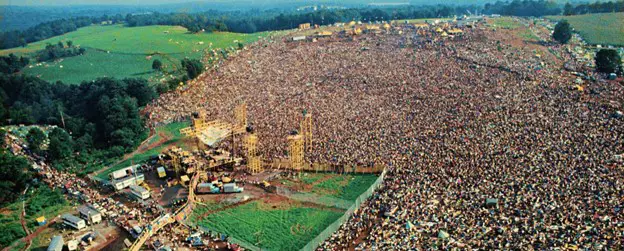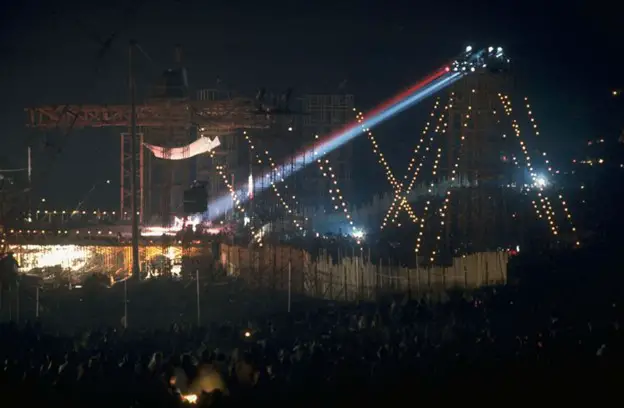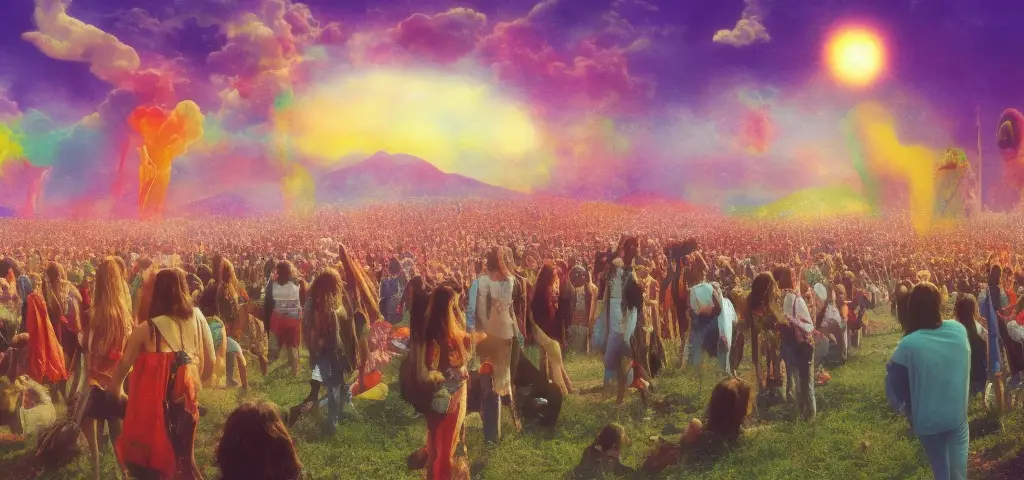|
Getting your Trinity Audio player ready...
|
What Bands played at Woodstock? Colloquially known as Woodstock ’69 we will always recognise the festival as one of the most legendary in the world. Not only for shutting an entire town down but also for putting a line-up together that no modern festival can comprehend.

Woodstock paved the way for many rock legends who were virtually unknown in the sixties. Crosby, Stills, Nash and Young stepped onto this DIY stage for the second show of their career. Santana joined the bill as a wildcard. And Jimi Hendrix, who was most famous in Europe and set to play the main slot on Sunday evening, only performed on Monday morning at around 9 am. Plagued by technical issues and horrendous weather, it was a miracle that every band got the chance to play.
So, what bands played at Woodstock ’69? There were 32 in all. These 12 were major acts – Jimi Hendrix – Janis Joplin – Santana – Jefferson Airplane – Ravi Shankar – Joan Baez – Canned Heat – Creedence Clearwater Revival – The Who – Ten Years After – Blood Sweat and Tears – Crosby, Stills, Nash and Young.
But no issue was big enough to stop this killer list of performers from protesting Peace, Love and Music alongside the other 500,000 attendees who gathered in Bethel, New York. The show simply had to go on, and it left the biggest footprint in rock music history.
Most articles, videos and books you will find cover this iconic festival in bits and pieces. This article, however, will uncover some of the best acts and moments that graced the stage over the historic weekend.
What was Woodstock ‘69?
The Woodstock Music and Art Fair, commonly known as Woodstock 69, was a historic event in August 1969. The festival featured a diverse lineup of 32 acts including some of the biggest names in rock, folk, and blues music history.
Headliners included Jimi Hendrix, The Who, and Janis Joplin – all of whom gave unforgettable performances. Other notable performers included Crosby, Stills, Nash & Young, Joan Baez, Santana, and The Grateful Dead.
The festival also featured several lesser-known acts, such as Keef Hartley Band and Bert Sommer, who helped to create a unique and eclectic musical experience.
The Bands that Played at the Original Woodstock in 1969
At festivals like Primavera Sound and Glastonbury, you can easily find hundreds and thousands of people flocking together to watch one of their favourite acts amongst the 500+ bands on their respective programmes.

Woodstock had a 32-act strong line-up, but little did the audience know the impact these acts would have on history. And you can bet acts like The Beatles, Led Zeppelin, and The Doors, who declined the offer to play at Woodstock 69, regretted their decision later.
During the weekend of August 15-18 in 1969 – no rules or regulations were met, timelines were a thing of the past, and yet everything was muddy and messy – yet every single band who played at Woodstock performed whether on time or hours and even days later.
What Bands Played at Woodstock – in order of appearance
Friday, 15 August 1969 – Day 1
- Richie Havens,
- Sweetwater,
- Sri Swami Satchidananda,
- Bert Sommer,
- Ravi Shankar,
- Tim Hardin,
- Melanie Safka,
- Arlo Guthrie,
- Joan Baez
Saturday, 16 August 1969 – Day 2
- Quill,
- Country Joe McDonald,
- Santana,
- John B. Sebastian,
- Keef Hartley Band,
- The Incredible String Band,
- Canned Heat,
- Mountain,
- The Grateful Dead,
- Creedence Clearwater Revival
Sunday, 17 August 1969 – Day 3
- The Who,
- Jefferson Airplane,
- Joe Cocker,
- Country Joe & The Fish,
- Janis Joplin,
- Ten Years After,
- The Band,
- Johnny Winter,
- Sly & The Family Stone,
- Blood, Sweat & Tears,
- Crosby, Stills, Nash and Young,
- Paul Butterfield Blues Band,
- Sha Na Na,
- Jimi Hendrix
Top 10 Key Moments for the Bands who Played at Woodstock
With a list of stellar performers, many standout moments needed celebrating. Let’s look at the Woodstock festival memories that rocked the music world to this day.
Richie Havens

Stepping onto the stage with a banged-up guitar, orange kaftan and rings adorning his fingers, Richie Havens set the tone for the rest of the bands that played at Woodstock.
As a folk artist, Havens was the perfect kick-off to this legendary festival with songs that echoed over the far-stretching farm and the sight of now the biggest gathering in the USA.
His distinctive husky tone bellowed an impromptu version of Motherless Child, which became famous as Freedom, that he played until the end of his career.
Richie Havens, was not supposed to play first, but he did so because some artists couldn’t get through the traffic in time. He set the stage for what Richie remembers in an interview with The Rolling Stone as: “an assemblage of such numbers of people who had the same spirit and consciousness.”
Sri Swami Satchidananda
When he walked onto the stage after Sweetwater who played second on the line-up, Sri Swami Satchidananda delivered a heartfelt message of love and peace, became known as The Woodstock Guru.

The festival organisers needed someone to calm the crowds, and at the suggestion of a friend, they called on Sri Swami Satchidananda to help. With a long grey beard, he sat down on a table covered with a white cloth and addressed the audience with these words:
“I am overwhelmed with joy to see the entire youth of America gathered here in the name of the fine art of music. In fact, through music, we can work wonders. Music is a celestial sound, and it is the sound that controls the whole universe, not atomic vibrations. Sound energy, sound power, is much, much greater than any other power in this world.”
Sri Swami Satchidananda
Joan Baez

With hope in her eyes, Joan Baez stepped onto the stage at 1 am on Saturday as the last act of Day 1. Joan was pregnant and she longed to be rejoined with her husband who was in prison for refusing to fight in the Vietnam War. It was a sad reality but fitting for why the festival was created.
Her story and immediate relation to the state of the USA resonated with the audience and their message of nonviolence in tough times in and around the festival.
Santana
There are almost no words to describe Santana’s electrifying performance at Woodstock ‘69. It was wild, it was sweaty, and the crowd devoured every second of it.

As people played on tins, danced with sheep, slipped and slid in mud – Santana’s energy carried from one festival goer to the next instinctively.
The crazy part is that Santana was not meant to be in the line-up. Relatively unknown at the time, their persistent manager got them on the bill.
Thank goodness he did as Soul Sacrifice was one of the mega moments over the weekend. Watch Santana performing this track here.
After the mesmerising performance at Woodstock, Santana quickly released their debut album, which landed at #4 on the US Billboard charts. Carlos Santana released many solo albums and is known as one of the best-selling guitarists on the planet.
The Grateful Dead

It comes as no surprise that The Grateful Dead’s performance was not published in the official Woodstock film. All the festival misfortunes worked against them, and they encountered an array of difficulties.
It rained profusely, and the resulting mud made things a nightmare on stage. The band could feel the electricity through their instruments literally giving a new meaning to electric rock – all while their heavy gear also contributed to the stage sinking into the wet ground.
The atmosphere for a groundbreaking performance was not right, and though The Grateful Dead was one band that had the potential to leave the audience begging for more, they did not. Unforgiving of the conditions of the day, many deemed their performance a failure.
Creedence Clearwater Revival
Creedence Clearwater Revival was one of the headliners of Woodstock ’69, yet many people didn’t know they played. Rumours speculate it is because they did not appear in the film.
The Woodstock ‘69 film was a major aspect in retelling and reliving the iconic festival and although the Creedence set was well-received, the industry believes, because of issues with their publicist, they were omitted from the movie line-up.
You may wonder if their impact on the music scene could have been bigger than it already was.
Joe Cocker

With A Little Help from my Friends – was made more famous by Joe Cocker than The Beatles could ever dream of.
Imagine this. It is Day 3 of a festival where you probably slept where you were watching the entire two-day line-up so far. With helicopters not only dropping food, but also daisies to spread good will, and then a man with a tye-dye shirt, shaggy hair and pinstriped jeans stumbles onto the stage and performs With A Little Help from my Friends from the depths of his soul with an unapologetic voice.
He gave hope to a festival that was turning into a disaster while the patrons kept positive. This song will remain in the history books as one of the greatest festival moments. And it made Joe one of the unforgettable bands who performed at Woodstock.
Sly & The Family Stone

Stone and his band were renowned for their psychedelic and groovy sounds, and with a solid encore from the crowd after their set at 5 am on Sunday – it is safe to say that Sly & The Family Stone was the grooviest band to feature at Woodstock ‘69.
Washed in a shade of blue, Sly’s rhythmic abilities and passion for music drove the crowd to chant “Higher” with him and his band – creating the perfect setting to welcome the daylight and the new week.
Crosby, Stills & Nash and Young
Not many people know this, but Crosby, Stills & Nash and Young were relatively unknown at the time. Woodstock was their second show in front of an audience and set the tone for their long and fruitful careers.

Stepping onto the stage, the band felt anxious, not from the energy of the crowd and a festival declared a state disaster, but because musicians like Janis Joplin and Jimi Hendrix were watching them from the wings.
The Woodstock Movie only features Crosby, Stills & Nash, but Neil Young performed with them too. He did not want to be featured in the film. So, the editors used one of the tracks as the soundtrack that shows the setup of the festival instead.
Jimi Hendrix

If you have not yet seen Jimi Hendrix’s set at Woodstock ‘69, stop reading this article and go check it out right now. Jimi’s performance is notably recognised for his rendition of the Star-Spangled Banner as his antiwar protest, however, this was not the first time he performed the National Anthem. Before setting foot on the Woodstock stage, he had played it 28 times before.
The Woodstock Festival was the first time Jimi played with an all-black band. The Experience was dismantled during this time, and Gypsy, Sun, and Rainbows was a temporary band he put together for this show.
Although Jimi and his new American band only played for around 200 000 people as many of the crowd had to leave for their homes, family and work – to him it did not matter. Jimi and his manager were adamant that he should close the festival. Even after the festival promoter offered him a midnight slot on Day 3, he flatly refused.
Jimi Hendrix, one of the guitar legends of our time, was The Beatles of 1969 – he was rock royalty, and the Woodstock ‘69 line-up was lucky to have him.
How Did the Promoters determine the Line-up?
Putting together a music festival lineup, is a delicate balancing act. On one hand, you want to make sure that you’re bringing in big-name bands that will attract a crowd. But you don’t want to rely on headliners and miss out on the up-and-coming acts that are making waves in the music scene.
This was the challenge that the promoters of Woodstock ‘69, Michael Lang, John Roberts, Joel Rosenman, and Artie Kornfeld, faced when putting together the festival’s list of bands.

One of the major factors they considered was the popularity of the bands at the time. After all, they wanted to make sure that the festival would be a success and attract a large audience. But they didn’t want to just rely on the headliners, they also wanted to showcase up-and-coming bands that represented the diversity of the music scene at the time.
So, they also considered the cultural and political context and sought to include bands that reflected the anti-war sentiment and civil rights movement of the late 1960s.
In addition, the promoters of Woodstock ‘69 had their artistic vision, they wanted to create a diverse and eclectic list of bands that showcased the range of musical styles and genres that were popular. This would help to create a unique and memorable musical experience for the audience.
The promoters of Woodstock found the perfect balance between established acts and new artists and took into account their social and economic surroundings. It’s a formula that not only made Woodstock ‘69 a success but also set the standard for music festivals to come.
The Bands of Woodstock Left a Legacy
If you were at this revolutionary event, you’re probably still recovering from the muddy, psychedelic whirlwind of music and culture that was the festival of the 20th century. But for those of us who weren’t so lucky to be in attendance, these were the bands that made it all happen.

The Who gave an electrifying performance that had the crowd on their feet, Jimi Hendrix closed the festival with a mind-blowing rendition of The Star-Spangled Banner that left everyone speechless, and Janis Joplin’s soulful and powerful voice had people reaching for their 3-day-old sleeves as the tissues were long gone.
But let’s not forget the other acts that made Woodstock this historic event. All the bands at Woodstock ’69 brought something unique to the line-up and left their mark on the festival and in the annals of music history.
All-in-all, it was a lineup that was truly ahead of its time.
Woodstock ’69 was about More than the Bands
Woodstock ‘69 was more than just the bands that played. It was a gathering of half a million people, a celebration of music, culture and a way of life. And while the bands that performed there were undoubtedly the stars of the show, there were other elements contributing to the festival’s iconic status. The counterculture atmosphere, the sense of community and unity among the attendees, and the peaceful and well-organised event, all contributed to making Woodstock a truly special moment.

But more than just a music festival, Woodstock also had a significant impact on the social and political issues of the time. A gathering that reflected the anti-war sentiment and civil rights movement of the late 60s, it showcased the counterculture lifestyle, the hippie movement, and all the ideals that came with it. It was a moment in time when people came together to celebrate peace, love, and rock and roll. So, while we might remember the legendary performances, remember the greater significance of Woodstock ‘69.
It was an event that defined a generation. And a continuing inspiration to those who believe nothing can transcend peace and love.

